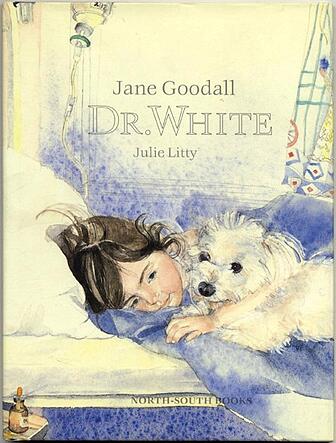Dame Jane Morris Goodall DBE, more affectionately known as Dr. Jane, is the world’s foremost expert on Chimpanzees, a United Nations Peace Ambassador, and an inspiration to budding ethologists the world over. Since making the discovery that chimps make and use tools while studying their behavior in the field more than half a century ago, she has become one of the most recognizable and beloved figures in the global scientific community. A few years back, we penned a post titled Ten Facts You Should Know About Jane Goodall. Here are ten more facts about her you may find of interest.
1. She discovered a lot more than just tool use

Though the fact that chimps used tools required humans to redefine their idea of what separates us from the animals, it wasn’t the only similarity that Goodall discovered between the two species. Like us, chimps also go through adolescence, show affection with hugs and kisses, practice politics, and wage war on ostensible enemies.
2. Her first trip to Africa got off to an…awkward start
Jane famously moved to Kenya as a young woman, where she met noted researcher Louis Leakey, who would ultimately send her to Gombe to study chimps. Before that happened, however, Leakey, despite being married with children, professed his love to the budding scientist. His profession was met with a curt refusal, but their friendship (seemingly) didn’t suffer.
3. She was briefly a baroness
Though Goodall was (probably fortuitously) not interested in the married Leakey, she would go on to marry her photographer, Hugo van Lawick. Or rather, Baron Hugo van Lawick. As a result, for the brief duration of their marriage, Goodall was an honest-to-goodness Baroness.
4. She (and her mother, and their cook) spent time in a prison camp
Jane famously had to be accompanied on her expedition by her mother, because the local powers didn’t believe it was safe for a young woman to be out in the woods by herself. As it turns out, there were some very real safety concerns afoot—specifically the civil war that had just broken out in the Belgian Congo. As a result of the conflict, it was determined that the safest place for Jane and her two-person entourage was a prison camp near Gombe, where they stayed until they were given the all-clear to head into the forest.
5. She was apparently a Lord of the Rings (1954) fan
Once Jane’s research got underway in earnest, it was not without its fair share of controversy. Most notably, many of Jane’s peers objected to her naming her subjects instead of numbering them. We at the Books Tell You Why blog have a general rule or staying out of scientific disputes, but on this score we have to express our appreciation for the fact that Goodall named one of her subjects Frodo, suggesting that she had at least read (and probably enjoyed!) J.R.R Tolkien’s classic fantasy epic.
6. Her methods were partially inspired by her childhood dog

Not only did other scientists criticize Goodall for naming her subjects, they were generally against what they perceived as a tendency to anthropomorphize the primates she was studying. Jane defended herself against her critics, saying, "You cannot share your life with a dog, as I had done in Bournemouth, or a cat, and not know perfectly well that animals have personalities and minds and feelings. You know it and I think every single one of those scientists knew it too but because they couldn't prove it, they wouldn't talk about it. But I did talk about it. In a way, my dog Rusty gave me the courage of my convictions." Of course, it turns out that Rusty didn’t belong to the Goodalls, but to the hotel down the road.
7. She’s cropped up frequently in pop culture
After publishing her first few books, Goodall’s popularity grew enormously. As she brought new knowledge about our close evolutionary cousins into the public consciousness, so did Goodall herself become an iconic figure in the popular imagination. As a result, she has taken the opportunity to voice a cartoonized version of herself on The Wild Thornberrys, as well as appearing on Reading Rainbow and numerous news programs and talk shows.
8. She got Gary Larson attacked by a chimp
One of the stranger instances of Jane Goodall cropping up in popular culture sprung from the mind of Gary Larson, creator of Far Side. Larson published a comic that depicted two chimpanzees grooming, in which one discovers a human hair on the other and asks, "Conducting a little more 'research' with that Jane Goodall tramp?" The Jane Goodall Institute was outraged, considered the joke to be in extremely poor taste, and wrote a strongly worded letter to that effect. Jane herself, who had been in the field during the time of the controversy, actually thought the cartoon was funny and put a stop to the Institute’s efforts to suppress the comic. She went on to write an introduction to one of Larson’s Far Side anthologies, and even invited Larson to Gombe, where he was promptly attacked by a chimp (Frodo, to be specific).
9. She hopes that Bigfoot exists
A self professed “romantic,” Dr. Jane is fascinated by Bigfoot sightings and thinks that there could be an as-yet undiscovered species of primate waiting to be found.
10. She has a boatload of honorary degrees
One of the most fascinating facts about Goodall’s career is that she began her groundbreaking research in ethology without having first received any sort of degree. Her early research was enough to earn her a PhD from Cambridge, but since then the academy has seemingly been paying her back with interest. She now has more than 40 honorary degrees, to say nothing of her innumerable other awards and honors.
Sources: Conservation Magazine, The Guardian, Comics Alliance









